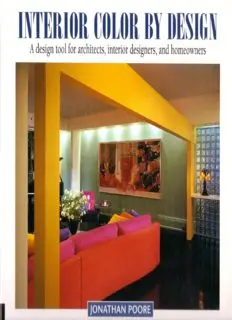
Interior Color by Design: A Design Tool for Architects, Interior Designers, and Homeowners PDF
Preview Interior Color by Design: A Design Tool for Architects, Interior Designers, and Homeowners
INTERIOR COLOR BY DESIGN A design tool for architects, interior designers, and homeowners JONATHAN POORE IN MEMORY OF RICHARD POORE, JR. Copyright © 1994 by Rockport Publishers, Inc. All rights reserved. No part of this book may be reproduced in any form without written permission of the coy yright owners. All images in this book have been reproduced with the knowledge and prior consent of the artists concerned and no responsibility is accepted by producer, publisher or printer for any infringement of copyright or otherwise, arising from the contents of this publication. Every effort has been made to ensure that credits accurately comply with information supplied. First published in the United States of America by: Rockport Publishers, Inc. 33 Commercial Street Gloucester, Massachusetts 01930 ‘Telephone: (978) 282-9590 Fax: (978) 283-2742 www.rockpub.com Singapore edition published 1994 by Rockport Publishers, Inc. for: ‘The Bookshop Pte, Ltd. Blk 4, Pasir Panjang Road 08-33 Alexandra Distripark Singapore 0511 Telephone: (65) 2730128 Fax: (65) 2730042 ISBN 1-56496-037-4 109 Printed in China Illustrations by Jonathan Poore INTERIOR COLOR BY DESIGN A design tool for architects, interior designers, and homeowners seaweed ena tuodyuooyr JONATHAN POORE COMWNeDE NTS INTRODUCTION PARTI 1 BASIC COLOR THEORY Attributes of Color Color Temperature How Colors Mix 2 ARCHITECTURAL CONSIDERATIONS IN COLOR DESIGN Color as an Architectural Design Ingredient Interactiveness of Color Relationships Color Hierarchy and Proportions Color Harmony 3 COLOR SCHEMES AND DESIGN EXAMPLES Monotone Schemes Monochromatic Schemes Analogous Schemes Complementary Schemes Discordant Colors for Special Effect 22 PART II COLOR SAMPLES 61 258 Color Combinations and Interiors GLOSSARY 149 BIBLIOGRAPHY 152 PHOTO CREDITS 155 INTRODUCTION he primary goal of Interior Color By Design is to equip the professional designer as well as the homeowner with the tools and understanding to use color effec- tively in architectural and interior design. It is designed to be used as a reference manual, an actual tool, to experiment with and design color schemes. Part I outlines the basics of color theory as they apply to interior design. Each principle of color theory is illustrated with specific examples of richly colored interiors to both explain the theory as well as spark the imagina- tion. Part IL, a virtual library of color ideas, is a compilation of sample color combinations. Each type of color scheme is shown in a sample interior and is followed with color chips showing variations on that color theme. ‘The greatest challenge in color design is to be able to predict and control the result of a color scheme. Effective color selec- tion can be an inexpensive yet powerful element in any design. Color can perform a multitude of roles and can affect a person’s emotions, energy level, and sense of order, or disorder. As well, it can set the tone of an interior and make it seem formal or informal, masculine or feminine, cooly aloof or invitingly warm. ‘The aim of successful interior color design is to be able to con- (rol these effects through the masterful use of color as a design tool itself. Interior Color By Design outlines some basic tech- niques that take the mystery out of the color design process. Color design can never be reduced to a science, but by becom- ing familiar with some basic rules of color theory it is possible to find a comfortable “jumping-off” point. With a basic under- standing of color theory it is possible to apply the rules fairly lit- erally and come up with conservative but successful color schemes. As a person’s skill and confidence increases, it is possible to take a more intuitive approach to color design, often bending the rules for more imaginative effects. ‘To communicate in words the subtle differences between indi- vidual colors is always difficult; there are virtually an infinite number of color combinations. To understand color and design with color, it is essential to have a basic knowledge of color the- ory. The first step in an organized understanding of color is to learn about the basic attributes and how they can be used to achieve dramatic and effective color design. aa 4 <j Ay CHAPTER 1: BASTG COLOR THEORY ATTRIBUTES OF COLOR HUE OR COLOR The first attribute of color is hue, which is the name for a color, such as yellow, green, blue, red. The color wheel is used to rep- resent the basic colors (hues) of the visible spectrum. All the hues indicated on the color wheel are of full intensity. For the sake of simplicity, the most common color wheel is made up of 12 color gradations, even though there are actually an infinite number of color gradations possible between each color on the wheel. Py, owe “ges "33uD 7, & “op Fig. 1.1 Color wheel RED VALUE OR LIGHTNESS The second attribute of color is value, or the relative lightness or darkness of a color. Lighter values are achieved by adding white to a color, and darker values result from adding black. CHROMA OR SATURATION The third attribute of color is chroma, or saturation, the relative purity or intensity of a color determined by how much or how lit- tle gray is added to the color. The value of the colors on a chroma scale do not change; only the intensity of the color varies. Fig. 1.2 Gray value scale and green value scale
